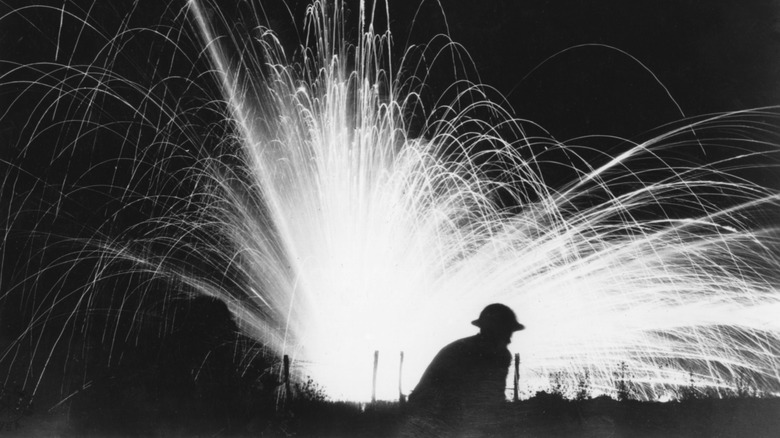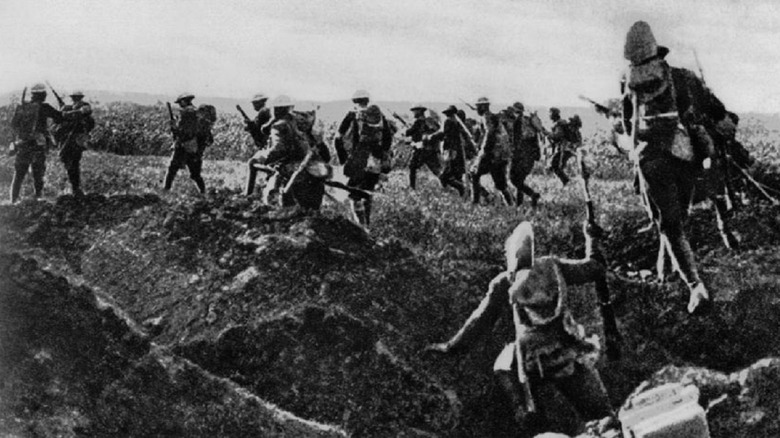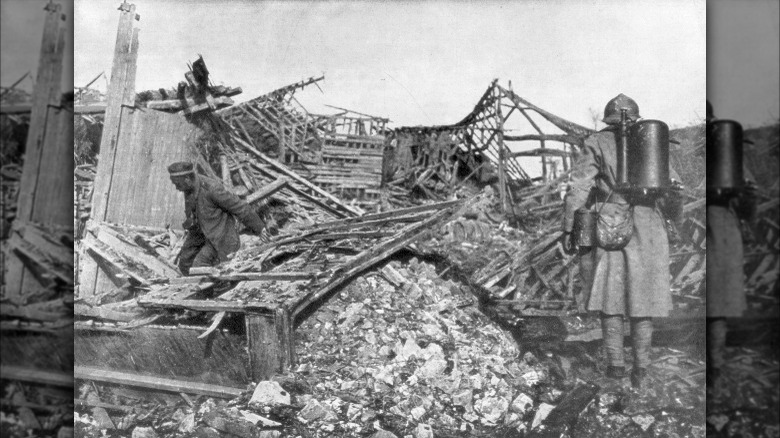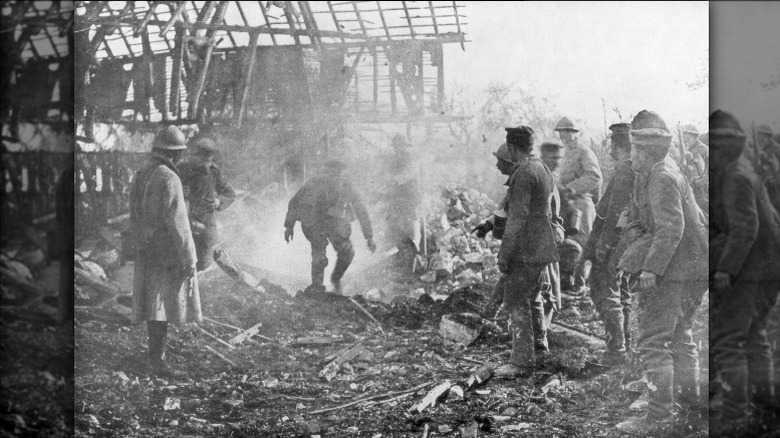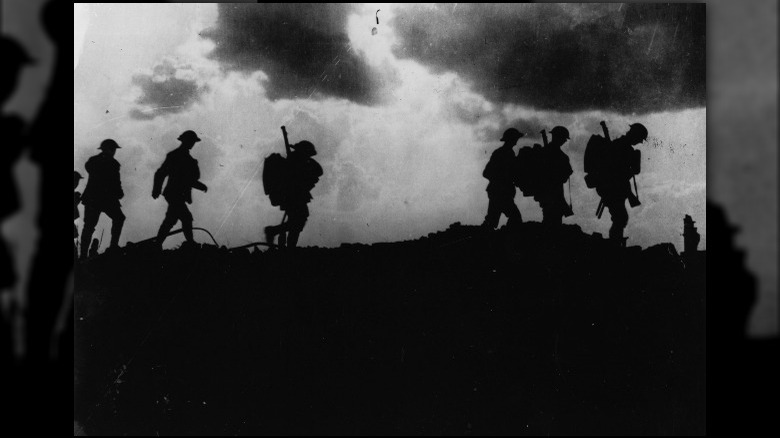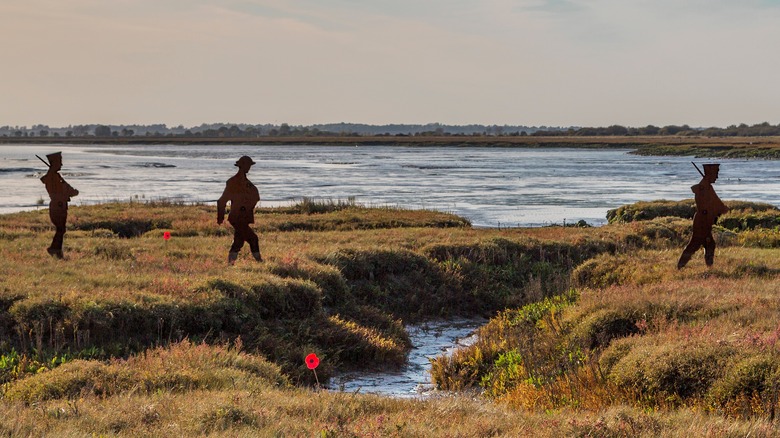The WW1 Battle That Changed The US Military Forever
Though many today might think of the United States as the biggest military force in the world, one hundred years ago the U.S.'s reputation was very different. The country had been embroiled with a European power in the Spanish-American War in 1898, but it was still considered a fledgling nation that focused on isolationist policies. It was also balancing Industrial Revolution growth against a deep schism caused by the Civil War in the mid-19th century.
With this in mind, it's little surprise that many of the European powers did not consider the United States' entrance into World War I a major game-changer. In fact, History on the Net noted that the sum of the armed forces included 127,000 army soldiers, 67,000 National Guardsmen in federal service, and 100,000 National Guard in state-based service. That put the U.S. in league with smaller countries like Portugal in regard to strength.
However, the lackluster perception surrounding the United States changed swiftly with the Battle of Cantigny. This small incursion marked one of the country's first major forays on the World War stage.
The U.S. enters the war, untrained and unprepared
Though the United States may have started with a relatively small amount of troops, the numbers quickly grew thanks to widespread enthusiasm to enlist as well as the draft. According to History on the Net, the U.S. had around three million troops by the end of the war, two-thirds of whom had been drafted. But, larger numbers weren't as important as experience, and American soldiers were severely lacking in that department.
Meanwhile, the European powers had already been at war for nearly four years. They were facing a stalemate in Northeastern France when the U.S. forces arrived under the leadership of Major General John J. "Black Jack" Pershing.
Though there were minor skirmishes in the fall of 1917, and most Americans received training throughout the cold winter and their first action in the spring of 1918. On March 21, German General Erich Ludendorff launched an offensive, code-named Michael, that sought to break through the Allied lines. Among the troops sent to defend the line were the American Army's 1st Division, known as the "Big Red One." It was the most well-trained division that Pershing had, and leadership was hoping the men would be able to make their mark in the Americans' first real fight of the war.
The build up to the battle
The Allied generals decided that a united force of French and American troops was needed to capture the town of Cantigny from the Germans. The location was chosen because it was elevated and thus a relatively important observational post. Moreover, Cantigny was one of the recent victories that the Germans had won and which threatened the strength of the Allied lines.
As described by Dark Docs, the stakes were high for the battle. Though Cantigny itself was not a vital strategic position, General Pershing knew that a victory was instrumental in showing American might and helping the morale of the French and British troops. Conversely, the Germans were determined to make the battle a stinging loss that would spread the impression that the American forces were useless and incompetent.
In the days before the battle, things already seemed to be going poorly for the American newcomers. As noted by History on the Net, a lieutenant engineer carrying important documents — including maps — had been captured and killed by the Germans. Morale was also low after General Ludendorff launched an attack that set the grounds for an invasion of Paris.
Even around Cantigny, the Germans raided the Americans just hours before the planned assault — meaning soldiers were already weary and tired.
The battle begins
Despite the action through the night, the offensive on Cantigny continued as planned. The battle started early in the morning — around 6:30 a.m. — on May 28, 1918. The man in command of the attack was General Charles P. Summerall.
According to First Division Museum, the assault began with mass bombing of the German lines. Using the smoke as a cover, French tanks began to make their way toward the small town. Using the tanks as a guide, American troops then charged forward with French aid. The details were meticulously planned — the tanks and troops would advance 110 yards every two minutes (via Dark Docs). This was deemed the best combination of speed with cover, and the premeditated ratio was masterfully successful.
Within just half an hour, Americans were using flame-throwers to dislodge the Germans from their trenches to fully secure the small town. This process ended up being nearly as fast as the charge itself, and within the hour, the Americans had taken the town in what was a striking victory.
However, the battle was far from over. The Germans were not ready to give up on Cantigny without a fight, and a counterattack seemed inevitable.
The darkest hours of the battle
The Germans were quick to try to retake the small town, and the first attempt to regain Cantigny started at 8:30 a.m. that same day. The morning counterstrike was easily repelled, per Dark Docs. However, the counteroffensive began in truth that afternoon, and German troops bombarded the Americans with heavy artillery. This was brutal for the U.S. forces, as they did not have the same firepower; the French artillery that was supposed to fight with the First Division had been sent to the Marne in response to General Ludendorff's surprise attack there.
With little in the way of artillery, the Americans had a meager defense against the relentless shells and machine gun fire (via History on the Net). By the evening, the Allied position was considered extremely fragile. Nevertheless, the division held firm for a full three days — the American desire for a victory ended up being the grit needed to hold out against each new wave of bombardments. By May 31st, relief troops were able to make their way to the small French town, and the Germans were ready to admit defeat.
But, it was not without a price. All in all, the regiment had suffered around 900 casualties from the three-day battle. The division suffered 1,600 losses.
The legacy of the battle
Though the Battle of Cantigny may not have been the most important or strategic of the war, it did have two important effects. The first is that it proved to the rest of the world that the United States was no longer a sleepy backwater but instead a major force to be reckoned with. The second is that it proved to Americans that they could hold their own against the Europeans, despite the fact that the continent's armies had more preparation and training than their U.S. counterparts. In fact, the battle of Cantigny ended up being a major point of pride and was used to shore up public goodwill towards both the war and American military might with televised reels of the assault, like this one restored by Periscope Film.
U.S. competence ended up being instrumental in ending the First World War. According to political scientist, Hein Goemans, the Germans had seen how long it had taken the British to prepare for war and assumed it would take the U.S. military just as long, if not longer (via the University of Rochester). This ended up being a miscalculation, and by November 11, 1918, the German army surrendered and World War 1 was over.
